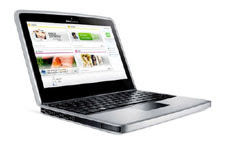Indeed, absent news of the Fab Four finally arriving on iTunes or the unveiling of the rumored Apple "iTablet," the reappearance of Jobs—who underwent a liver transplant in April during a six-month leave of absence—was the biggest news of the day.
Dressed in his standard uniform—black turtleneck, jeans, and sneakers—Jobs still looked a bit gaunt but otherwise "good," as the
bloggers at Engadget noted. The recuperating Jobs got a long standing ovation as he took the stage, then told the rapt audience that he now uses the transplanted liver of a 20-something man who died in a car crash.
"I'm very happy to be here today with you all," said a thankful Jobs, who urged everyone at the event to become organ donors themselves. "I'm vertical, back at Apple, and loving every day of it."
And with that, Jobs launched into the product demos, including ...
 New iPod Touches
New iPod Touches
Unfortunately,
rumors of a Touch with a built-in camera didn't materialize; what we did get, however, was a 64GB version of the Touch to go with the existing 32GB and 8GB models. (The old 16GB version is, for now, MIA). Both the 64GB and 32GB Touches boast "50 percent" faster performance and OpenGL-enhanced graphics, according to Apple, while the 8GB model is stuck with the old, slower Touch processor. Pricing for the new Touches (all available now): $399 for the 64GB version, $299 for the 32GB, and $199 for the 8GB. (Oddly enough, the new price tags conflict with the Touch price drops that were revealed
on the Apple Store earlier today.)
 New iPod Nano, with built-in camera
New iPod Nano, with built-in camera
While the Touch didn't get its own camera as expected, the Nano sure did—a VGA-quality, 30 frames-per-second camera, specifically, along with the ability to sync videos to iPhoto or the Photos directory on a PC. The new Nano also comes with a larger, 2.2-inch display, an FM radio, pedometer, voice recorder, and a built-in speaker, as well as support for the new Genius Mixes (more on that in a moment). Prices: 16GB for $179, 8GB for $149.
Updated iPod Classic, Shuffle
Nothing major to report here, except that the Classic now ships with a 160GB hard drive for $249, while the Shuffle—now with the ability to tell you via VoiceOver when its battery is full—will sell for $59 (2GB), $79 (4GB), and $99 (a 4GB stainless-steel special edition).
 iTunes 9 & iTunes LP
iTunes 9 & iTunes LP
As expected, we also got our new digital album format: iTunes LP, a slick digital package for full music albums that includes album art, liner notes, credits and "other customized content." The main interface for an iTunes LP-formatted album looks something like a DVD menu, complete with options such as Play Album, Song List, photos, videos, memorabilia, liner notes, and credits; Jobs also mentioned that the artists themselves may collaborate on iTunes LP design (for instance, we got an example from a Dave Matthews LP, with artwork drawn by Matthews himself). It's a sleek looking package, all right, but (at first blush, at least) somewhat short of earth-shattering; while it's a nice bonus for those who buy complete albums, I doubt it will put much of a dent in the trend of buying individual tracks on iTunes.
Also new: "iTunes Extras," which will deliver the same types of extra features for purchased movies that you'd expect from a DVD, such as featurettes and deleted scenes. (Director and cast commentaries, anyone?)
Sharing movies, TV shows, and songs across multiple computers in your home will also be easier thanks to "Home Sharing," a new iTunes feature that'll let you view, stream, and copy your content between up to five systems on a home network—no more need to dig into your iTunes folder and copy content manually.
Jobs & company also showed off Genius Mixes, an extension of the Genius recommendation feature in iTunes that creates "endless mixes of songs" that "go great together, almost like radio stations" starting with 12 mixes based on the tunes in your iTunes library. Another new Genius feature: recommendations for apps, in addition to music.
Meanwhile, iPhone and iPod Touch users with dozens of apps will appreciate this next feature: the ability to manage and organize all the apps on your iPhone/iPod Touch via iTunes, all without having to (clumsily) drag icons back and forth on the device itself.
Other new iTunes 9 features: a cleaned-up iTunes Store interface (with a navigation menu above every page that lets you jump to any section of the store), improved iPod/iPhone syncing (for example, you can now sync entire genres and artist collections), and the ability to preview songs or videos by mousing over them from the iTunes "top charts" listings.
The new Genius features for the iPhone and iPod Touch will be enabled by iPhone Software 3.1, which Jobs said will be available later today. (More details on the new firmware as we get them.)
What we didn't get
No
Beatles on iTunes, again (despite today's date, 9/9/09). No sign of the long-rumored iTablet. No built-in video camera for the Touch, or any other iPod besides the Nano. No mention of Apple TV.
So, what do you think: Psyched by the new Nano? Like the idea of iTunes LP? Feeling underwhelmed? Let us know.










